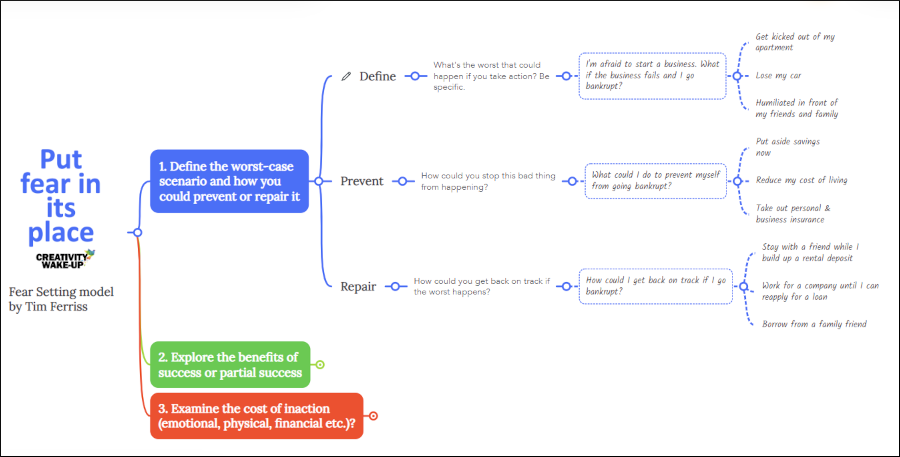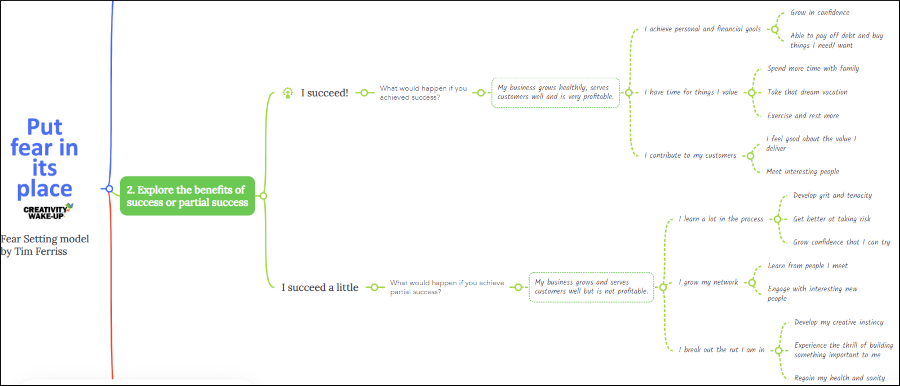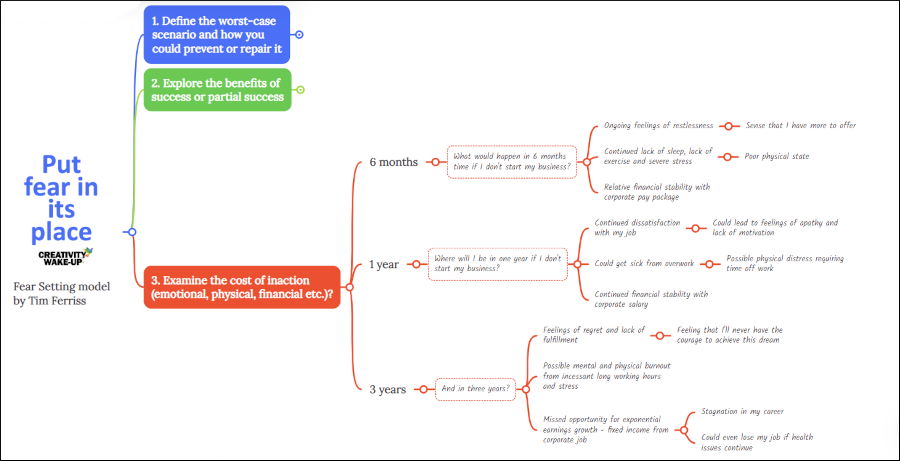
“I had no idea what I was doing. I was working 14 plus hour days, seven days a week. I was using stimulants to get going. I was using depressants to wind down and go to sleep. It was a disaster, felt completely trapped.” (1)
 These are the words of entrepreneur, investor, and author, Tim Ferriss.
These are the words of entrepreneur, investor, and author, Tim Ferriss.
In 2004, he was working in his first business and was weighed down by overwork and the fear of failure. Although Tim was working non-stop, he was not making enough progress to stabilize his business and establish work-life balance.
Then he came across this profound observation by the great Roman Philosopher, Seneca:
“We suffer more often in imagination than in reality.”
Fears fade in the harsh light of reality
This idea had a powerful impact on Tim. He began to wonder whether his fear of his business failing was reasonable or whether his imagination was creating unrealistic dread. He began to explore Seneca’s ideas further. He found that the great philosopher used a method to confront his own fears called “the pre-meditation of evils” (“premeditatio malorum”) in which he thought of the very worst case scenario of his intended action. He fully imagined, or sometimes even enacted, this scenario. Seneca found that this tended to make the fear manageable enough for him to take action.
Tim decided to put Seneca’s method to the test.
First, he asked the key question, “What if … ?” “What if I took a month-long sabbatical to regain my health and work-life balance and during that time my company went insolvent?” If this worst scenario played out, Tim would lose his car, apartment and his income.
Then what? How would he survive? One solution that came to him was that he could move in with a friend. He would need to rely on family and friends for a bit of cash until he could get on his feet again.
What would this feel like? Could he get through it emotionally? He decided to put this to a test. He moved in with a friend in London for a month. Far from his business collapsing, it was the start of great things to come. He wore the same jeans and T-shirt for a week. He lived on “very cheap food, rice and beans for instance, two to three dollars a day in total cost, for a week.” (2)

He found the experience completely liberating. His greatest fear of going bankrupt dissolved into thin air. He realized that if it really happened, he could make a plan. Tim says that he still challenges himself from time to time by “practicing poverty” to make sure that this fear does not hold him back from taking action with his businesses. This practice helps him to inoculate himself from fear. He rehearses the thing that he fears and the fear dissipates.
How to use the Fear Setting Method
Tim adapted Seneca’s method and created a simple Fear-Setting framework which is similar to a goal-setting framework.
Here’s how it works: We often set our goals, but we do not set our fears. If you have not done this before, I encourage you to try something new and use mind mapping to explore Fear Setting. Take something that you are really afraid of and bring that fear out into the light. Our fears tend to be quite vague. You can have a feeling of dread that is very real, but hard to put our finger on. Get it out into the light and see whether the Fear Setting can help you break through the fear and into action.
In a nutshell, the first step is to write down whatever you are afraid of and describe the worst possible outcomes of that fear. Ask yourself, “What if I… ?” Then work out what you can do to prevent these outcomes from happening and how you could repair or recover from them if they do happen. The next step is to write down the all potential benefits of pushing through your fear. Finally, you look into the future and think about the cost of inaction of you let fear hold you back from your dream or goal.
Now it’s up to you to try the Fear-Setting framework:
- Set aside 15 minutes or half an hour to start the exercise.
- Get out some paper and pens or your favorite mind mapping tool.
- Bring to mind a significant fear that is plaguing you. Not the fear of heights or the fear of losing a deal next week. Try something that is quite a big, long-term fear in your life. Something that you have the ability to control that is stopping you from a creative expression you desire, for instance starting a new business, getting into or out of a relationship, writing a book, moving to a new location or learning a new skill.
- Start with a mind map and say “What if I…?”
[NOTE: CLICK ON THE IMAGES TO VIEW LARGER VERSIONS OF EACH MIND MAP]
Step 1: Define the worst-case scenario and how you could prevent or repair it

The first step is to say, “What if I actually do this and I completely fail?” This step is broken into three parts, “define”, “prevent” and “repair.”
Start by defining the worst that could happen if you take action. Use your mind map to note down every bad consequence that you can think of. In Tim Ferriss’ case, he was afraid of going bankrupt. What would that be like? Be very specific. If you have similar concerns to Tim, you may think, “I would have to borrow money from friends. I would have to move back with my parents. I would be embarrassed and look like a fool in front of my friends. I wouldn’t be able to pay my loans.”
Lay it all out. Picture yourself telling your friends. How would they really react? This is in itself a powerful step, as you may realize that you will get a lot more support from friends and family than your fears let you imagine.
After you’ve defined the worst case, look at how you could prevent this scenario from developing. You might think, “I could start putting aside some savings. I can reduce my cost of living and take out personal or business insurance.” When you face this scary thing and start taking steps, you will begin to feel more confident and the power of fear over you will be reduced.
Then consider how you could repair the damages, if this terrible thing actually happens. Is it going to be like that forever? How could you get back on track? Let’s say you lost everything and you went insolvent. What would you do? When you put your mind to it, you will most likely find that are ways out and there are things you will be able to do to rectify the situation.
So that is the first step, we “define”, “prevent” and “repair.”
Step 2: Explore the benefits of an attempt or partial success

The second step is to consider what might be the benefits of an attempt at action. What would happen if I succeed or partially succeed? This is the next main branch of your mind map. What if things go well? Wow…imagine this works?
This is the fun part. Tap into your imagination, do some dreaming, and think about all the possible positive outcomes if your endeavour is a success, or even if it is just a partial success. Don’t stop at the first three ideas you think of. Use some creative thinking tools to stretch your mind’s eye and think more expansively. This will be an exciting mind map to make.
Step 3: Examine the cost of inaction
The final step is to look at the cost of inaction. What if I do absolutely nothing? What will the emotional, physical and financial cost be? This step can be a powerful motivator to move you into action. Ask yourself, “Am I really happy staying with the current status quo and not facing this fear?” Think of the effect over the next six months, year and three-year time frames. Add this to your mind map.
Make a habit of doing things that scare you
I hope that you will give this exercise a try. I’d love to know how your mind map works out and the impact of ‘premeditatio malorum’ on the achievement of your goals.
My parting shot on this topic is encourage you to make a daily practice of doing things that scare you. Tim Ferriss fears criticism and people’s opinions about him. He tells a hilarious story of how he sometimes deliberately creates awkward social situations to inoculate himself to these fears. He says, “I have my party pants, which are these ridiculous pants that look straight out of Austin Powers. And I will occasionally wear those… in a place where I know that I am going to get these sideways glances from everyone.” (3) Tim trains himself to acknowledge and face his fears with small things like wearing his party pants. Then when he has to overcome fears about big, important things, he has built the mental muscle he needs to wrestle his fears and take action.
References:
(1) TED Talk: Why you should define your fears instead of your goals | Tim Ferriss. July 14, 2017
(2) The Tim Ferriss Show Transcripts Episode 137: How To Practice Poverty and Reduce Fear
(3) The Tim Ferriss Show: How to cage the monkey mind
Celia Falkenberg is the director of Creativity Wake-up, an innovation consultancy and training firm. She is a creative educator with a passion to inspire and equip people to find creative solutions to challenges and opportunities in business and everyday life. Celia is an award-winning professional architect with a Master’s degree from The Architectural Associate School of Architecture in London. Celia uses her experience and skills in design thinking to design and facilitate courses in creative thinking and innovation. Got questions? Need help? Email Celia at info@creativitywakeup.com.


Leave a Reply